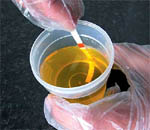Normal urine test results

In the following article, we present some of the blood parameters, description and values considered correct for women (K) and men (M)
The daily amount of urine
It mainly depends on the amount of fluids you drink, the thermoregulation system and the functioning of the urinary system.
Rule: 0.6 – 2.0 l / age
Relative urine density
It mainly depends on the amount of fluid ingested, the presence of solids in the urine and the ability of the kidneys to concentrate the urine.
Rule: usually: 1.016 – 1.022 kg / l (N/l), po 24 h refraining from drinking fluids: 1.026 – 1.035 +/- 0.4 kg / l
Discoloration of the urine
It depends on the presence of dye substances and on the relative density.
Rule: transparent, straw
Changes: cloudy, yellow-brown, bloody, red-brown, green, blue, black, Violet, orange
Urine reaction
It depends on the substances present in the urine, which is mainly influenced by nutrition and medical conditions.
Rule: slightly sour, pH (medium) = 6.2, pH (min-max) = 4.6 – 8.0
Protein
In healthy people, the amount of protein excreted in the urine does not exceed 100 could go on 24 h, average amounting to 40 – 80 mg. This amount is usually undetectable by routine methods.
Rule: protein – nb (absent)
Proteinuria is a state of excretion in the urine over 150 mg of protein per day.
Urobilinogen
Its concentration mainly reflects the function of the liver and bile ducts and the metabolism of hemoglobin.
Rule: urobilinogen – N (rule)
Sugar
Normal urine contains small amounts of carbohydrates.
Rule: sugar – nb (absent)
Ketone compounds
In a disposable urine sample, the presence of ketone compounds is most often the result of a feverish state, vomiting, starvation, and also when following a low-sugar diet, and high-fat. Less common causes are diabetes and uremia.
Rule: ketone compounds – nb (absent)
Red blood cells – Erythrocytes (E)
In a normal urine image, there should be no more red blood cells than
Rule: 0 – 3 wpw (in the field of view)
Hematuria – presence of red blood cells detected by urine sedimentation.
Hematuria – blood in the urine can be seen with the naked eye.
White blood cells – Leukocytes (L)
Rule: 3 – 5 wpw (in the field of view)
Rollers
These are castings of the kidneys and a small number of vitreous rollers may be present in normal urine.
Some other types of rollers are: epithelial (fresh, coarse-grained, waxy, fatty, wide, from cancer cells), mucous, hemoglobin, myoglobin, globin, from Bence-Jones protein, alleged (crushed crystals, glutinated blood cells, degenerated sperm, other artifacts).
Crystals
Uric acid crystals may be present in normal acidic urine, urates and calcium oxalate.
Ammonium urate crystals may be present in normal alkaline urine, magnesium ammonium phosphate, calcium phosphate, and calcium carbonate.
Bacteria
Most often they come from external pollutants and therefore the method of collecting urine for analysis is important. Well, urine should be collected from the so-called. middle stream (that is, not at the beginning and end of urination) after thoroughly washing the urethral area. If, despite the correct method of downloading, there are bacteria in the urine, it may be an infection of one part of the urinary tract (urethra, bladder, renal pelvis or kidneys).
Rule: bacteria – nb (absent)